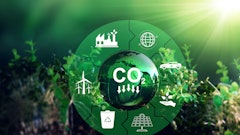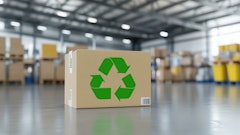
Modern manufacturers are increasingly thinking in terms of energy efficiency, carbon footprint and renewable materials. But long before the term environment, social and governance (ESG) went into effect, lean thinkers were already prioritizing sustainability.
That’s because, by relentlessly rooting out waste and prioritizing efficiencies, lean practices also naturally reduce environmental impact.
The 8 wastes, revisited through a sustainability lens
Lean manufacturing stems from the Toyota Production System (TPS), where Taiichi Ohno worked to eliminate waste and drive efficiency in a particularly resource-poor, post-war environment. The TPS defined seven wastes, or processes that consume resources but fail to add value, with an eighth added later.
Those wastes can be remembered by the acronym DOWNTIME, and when turned on their head, provide natural opportunities for increased sustainability.
Defects
Errors lead to scrap, rework and overall waste. Every defective part represents raw resources, energy and labor that will never deliver value.
So, by focusing on accuracy and quality, companies can also improve material efficiency, lower labor costs and better utilize resources overall.
Overproduction
Manufacturing more goods than necessary creates inventory that can expire, becoming obsolete while requiring storage space and transportation resources. This translates to higher energy use and carbon emissions.
Instead, fine-tuning demand planning and production scheduling processes allows the creation of only what’s needed when it is needed, cutting down on key resources poured into dead stock.
Waiting
Idle machines, people, and materials extend cycle times, consume energy, and sometimes, with temperature-controlled goods, consume more cooling.
Alternatively, simply improving flow, by optimizing the movement of materials and work from one operation to the next, can significantly reduce idle time and meaningfully improve energy consumed per product delivered.
Non-utilized talent
When new insights and ideas are stifled, we miss out on opportunities to innovate greener processes.
On the other hand, tapping employee creativity for sustainability solutions builds engagement and strengthens the “social” dimension of ESG.
Transportation
Every unnecessary mile adds avoidable emissions, and every move costs energy, especially when done with a forklift or vehicle.
As such, by designing supply chains to shorten movement, you can cut both costs and carbon.
Inventory
Excess stock ties up limited space and resources. In the food and chemical industries, you might also see spoilage and hazardous waste. You also run the risk of making something that becomes obsolete or is never sold.
Lean practices translate to less storage space, refrigeration and handling, again driving both lower emissions and improved efficiency.
Motion
Inefficient factory floors waste human energy and extend machine use. Every movement could cause damage to the goods. These can lead to heightened ergonomic risks, defects, and increased power consumption.
By simply reorganizing factory layouts and workflows, manufacturers can save energy, cut down on ergonomic strain and support key health and safety standards.
Extra processing
Of course, any unnecessary steps during production consume additional energy, water or chemicals. Extra inspection and change orders can cause processing that could have been avoided.
Eliminating those processes via lean manufacturing principles limits that waste and could be tracked as efficiency gains in environmental disclosures.
Each lean waste highlights a clear opportunity to advance sustainability goals and reporting metrics.
Sustainability via lean manufacturing in action
Manufacturers addressing the eight lean wastes are already gaining measurable ground in becoming more sustainable.
Take a manufacturer, for example, that lacked space for a certain process in its main plant. Product had to be loaded onto trucks, driven to a secondary site, processed and then hauled back. There was unnecessary motion and waste from the added emissions to the transportation costs.
By redesigning the facility layout, improving demand planning and consolidating those key processes under one roof, efficiency and sustainability markedly improved.
Even underutilization of data can generate environmental waste. Some manufacturers are still working out of disconnected spreadsheets, which means they’ll often build excessive inventory just in case. That overstock goes directly against both lean principles and sustainability best practices.
But by connecting data and applying predictive analytics, forecast accuracy and subsequent production scheduling processes can meaningfully improve. For example, a materials producer leveraged data and AI-enabled demand planning tools to improve forecast accuracy by over 60%, translating into nearly one-third less excess stock, thousands of hours freed and fewer wasted raw materials. This innovation served as a win for both the business and the environment.
Get started leveraging lean
Lean is clearly a powerful driver for sustainability, but manufacturers need to approach adoption with strategy and intention.
For example, lean frames improvement as continuous, not a one-off project. This means leaders should invest in dedicated improvement teams to identify where waste hides in daily operations, from routing trucks to stocking spare parts, and apply the right technologies or process changes to reduce impact. Then, do it again and again. The goal is always continuous improvement, especially as business processes and operations change.
Lean thinking in product design is crucial. For example, to reduce packaging or fit more product onto a standard container or truck. Physical factories and warehouses can be optimized, too, and decisions like window placement, insulation and solar integration can play a critical role in energy use for decades to come. Certifications like Leadership in Energy and Environmental Design (LEED) offer frameworks to ensure facilities are designed to be sustainable and efficient.
Finally, don’t overlook the value in starting now. Nothing improves until you start recording and studying the data. Establishing even a simple baseline, on energy use, material waste or greenhouse-gas output, creates the foundation for truly transformational improvement.
The missing piece of your ESG strategy
Lean can improve profits and drive customer satisfaction. But manufacturers shouldn’t overlook how a lean approach meaningfully supports ESG goals and sustainability reporting.
Defects avoided, miles eliminated, and hours of reduced idle time translate directly into mitigated environmental impact and, as a result, differentiation.
As such, the companies that embrace lean as both a business and sustainability strategy today will be better positioned to thrive in the decades ahead.



















